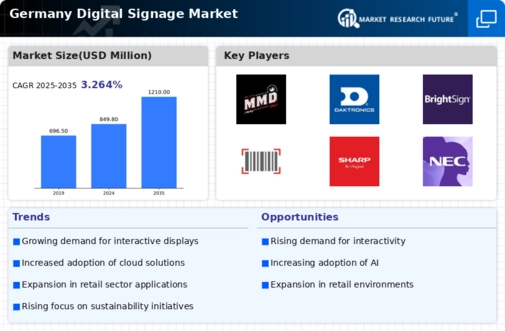Expansion of Smart Cities
The development of smart cities in Germany significantly influences the digital signage market. As urban areas evolve, the integration of digital signage into public infrastructure becomes essential for effective communication and information dissemination. Smart city initiatives often include the deployment of digital displays for real-time updates on transportation, events, and public services. This integration not only improves the efficiency of urban management but also enhances the overall citizen experience. The digital signage market is likely to benefit from government investments in smart city projects, which are projected to reach €100 billion by 2030. This investment indicates a robust growth potential for digital signage solutions within urban environments.
Growth of Advertising Expenditure
The digital signage market in Germany is positively impacted by the increasing expenditure on advertising. As businesses seek innovative ways to capture consumer attention, digital signage emerges as a compelling medium. The advertising sector is projected to grow by 5% annually, with a significant portion allocated to digital formats. This shift towards digital advertising is likely to enhance the visibility and effectiveness of marketing campaigns. Moreover, the ability to update content in real-time allows advertisers to respond swiftly to market trends, further driving the adoption of digital signage solutions. Consequently, the growth in advertising expenditure is expected to bolster the digital signage market, providing businesses with enhanced opportunities for engagement.
Integration of Artificial Intelligence
The integration of artificial intelligence (AI) into digital signage solutions is emerging as a transformative driver in the digital signage market. AI technologies enable personalized content delivery based on audience analysis and behavior tracking. This capability allows businesses to tailor their messaging, thereby increasing engagement and conversion rates. In Germany, the adoption of AI in digital signage is projected to grow by 20% over the next few years, reflecting a broader trend towards data-driven marketing strategies. The ability to analyze consumer data in real-time and adjust content accordingly positions AI as a critical component in the evolution of the digital signage market. This integration not only enhances user experience but also optimizes advertising effectiveness.
Rising Adoption in Transportation Hubs
The digital signage market in Germany is witnessing increased adoption within transportation hubs, such as airports and train stations. These locations require efficient communication systems to manage passenger flow and provide timely information. Digital signage solutions offer dynamic content delivery, which is crucial for enhancing traveler experience. Recent statistics indicate that the transportation sector accounts for approximately 25% of the digital signage market share in Germany. The ongoing modernization of transportation infrastructure, coupled with the need for real-time updates, is likely to drive further investments in digital signage technologies. This trend suggests a promising outlook for the digital signage market as transportation hubs continue to evolve.
Increased Demand for Interactive Displays
The digital signage market in Germany experiences a notable surge in demand for interactive displays. This trend is driven by the growing need for engaging customer experiences in retail environments. Interactive displays facilitate real-time customer interaction, enhancing brand engagement and driving sales. According to recent data, the market for interactive digital signage is projected to grow at a CAGR of approximately 15% over the next five years. Retailers are increasingly adopting these technologies to create immersive shopping experiences, which is likely to contribute to the overall growth of the digital signage market. Furthermore, the integration of touch technology and gesture recognition in displays is expected to enhance user engagement, making it a pivotal driver in the digital signage market.




















Leave a Comment